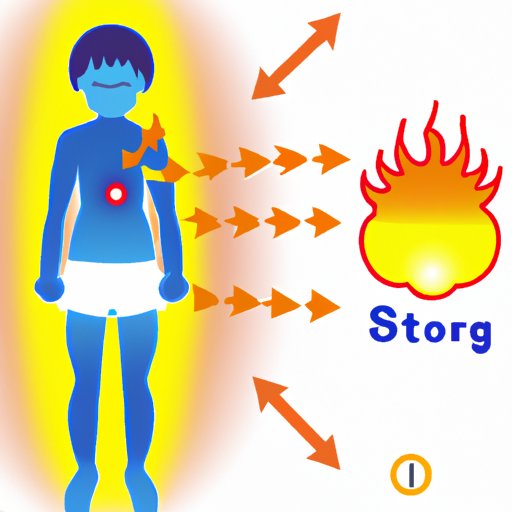Introduction
Exercise is an essential part of a healthy lifestyle. It helps to strengthen your muscles, enhance your cardiovascular fitness, and boost your overall wellbeing. But have you ever wondered why you get warm when you exercise? This article will explore the physiological reasons why your body temperature increases during physical activity, as well as the potential benefits of getting warm while working out.

Exploring the Physiological Reasons Why You Get Warm When You Exercise
Your body has a natural process called thermoregulation that regulates its temperature. This process involves the hypothalamus, which is a small area in the brain that senses changes in body temperature. When your body temperature rises, your hypothalamus signals your body to start cooling down by sweating, increasing blood flow to the skin, and other methods.
When you exercise, your body produces heat. This happens because your muscles are constantly contracting and releasing, which requires energy. This energy is released in the form of heat, which causes your body temperature to increase. The harder you work out, the more heat your body produces, resulting in a higher body temperature.
In addition to producing heat, exercise also increases your body temperature through increased blood flow. When you exercise, your heart rate increases, causing your blood vessels to dilate. This allows more blood to be pumped around your body, which in turn increases your body temperature.
Harnessing the Power of Heat: How to Use Your Body Heat to Improve Performance
The heat produced by your body during exercise can be harnessed to help you perform better. Studies have shown that athletes who use their body heat to their advantage have better results than those who don’t. This could be due to the fact that increased body temperature enhances physical performance by improving muscle coordination and reaction time.
One way to make use of your body heat is to warm up before your workout. This helps to increase your core temperature, allowing you to move more efficiently and with greater power. Wearing appropriate clothing can also help to keep your body temperature regulated. Choose lightweight, breathable fabrics that allow your body to ventilate and cool down easily.
Understanding the Benefits of Getting Warm While Exercising
Getting warm while exercising offers several benefits. One of the main advantages is improved physical performance. Research has shown that increased body temperature can enhance strength, speed, and endurance. In addition, increased body temperature can help to reduce fatigue and improve concentration and focus.
Getting warm while exercising can also help to reduce injury risk. This is because increased body temperature can help to lubricate joints, making them less susceptible to sprains and strains. Additionally, warm muscles are more flexible and less likely to tear.

How to Manage Overheating During Exercise
Although getting warm while exercising can be beneficial, it’s important to take steps to prevent overheating. If you become too hot, your performance may suffer and you may be at risk of heat-related illnesses such as heat exhaustion and heat stroke. To avoid this, take regular breaks to allow your body to cool down, and drink plenty of fluids to replace any lost through sweat.
If you do become overheated, move to a cooler environment and remove any extra layers of clothing. You should also apply a cold compress to your skin to help lower your body temperature. If symptoms persist, seek medical attention.
Keeping Cool: Tips for Staying Comfortable While Working Out
To stay comfortable while exercising in warm conditions, it’s important to wear the right clothing. Choose lightweight, breathable fabrics that wick away moisture and allow your body to ventilate. Also, try to avoid wearing too many layers, as this can trap heat and cause your body temperature to rise.
It’s also important to stay hydrated. Drink plenty of water before, during, and after your workout to replace any fluids lost through sweat. Additionally, try to exercise in the shade or indoors to avoid direct sunlight, which can further raise your body temperature.

The Relationship Between Exercise and Temperature: What You Need to Know
Understanding the relationship between exercise and temperature is important for staying safe and comfortable while exercising. Temperature can affect physical performance, so it’s important to consider the temperature when planning your workouts. Extreme temperatures can be dangerous, so exercise caution if exercising in extreme heat or cold.
Factors such as air temperature, humidity, clothing, and wind speed can all affect your body temperature during exercise. Additionally, age, gender, and fitness level can play a role in how your body responds to temperature changes. It’s important to remember that everyone responds differently to temperature, so be sure to listen to your body and adjust accordingly.
Conclusion
In conclusion, understanding why you get warm when you exercise is an important part of staying safe and performing optimally. Your body produces heat during exercise, which increases your body temperature. Harnessing this heat can be beneficial, as it can improve physical performance and reduce injury risk. However, it’s important to take steps to manage overheating, such as drinking plenty of fluids and wearing appropriate clothing. By following these tips, you can stay comfortable and safe while reaping the benefits of getting warm while exercising.
(Note: Is this article not meeting your expectations? Do you have knowledge or insights to share? Unlock new opportunities and expand your reach by joining our authors team. Click Registration to join us and share your expertise with our readers.)
